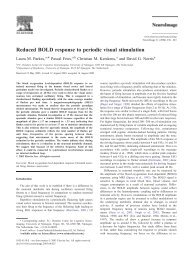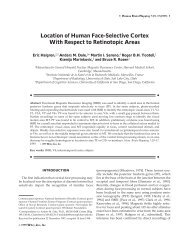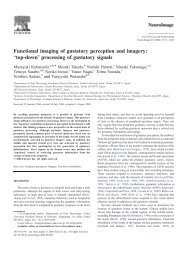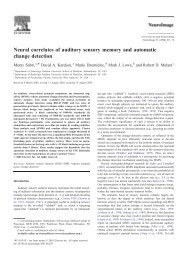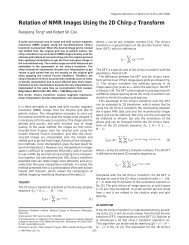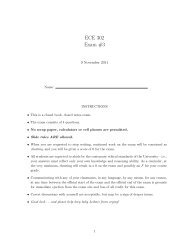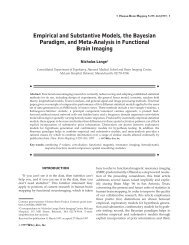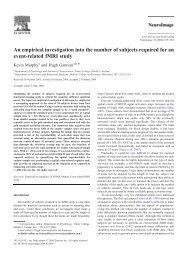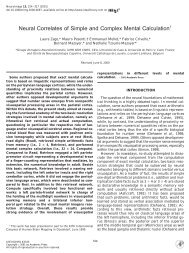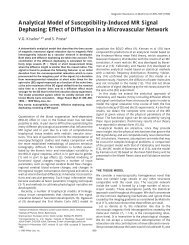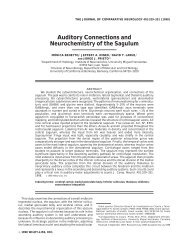Bias and Efficiency in fMRI Time-Series Analysis - Purdue University
Bias and Efficiency in fMRI Time-Series Analysis - Purdue University
Bias and Efficiency in fMRI Time-Series Analysis - Purdue University
You also want an ePaper? Increase the reach of your titles
YUMPU automatically turns print PDFs into web optimized ePapers that Google loves.
208 FRISTON ET AL.<br />
<strong>Bias</strong>S, V i <br />
Varc T ˆ GLS Vˆ arc T ˆ GLS<br />
Varc T ˆ GLS<br />
1 traceRSV iS T c T SX SV a S T SX T c<br />
traceRSV a S T c T SX SV i S T SX T c .<br />
(B.4)<br />
The critical th<strong>in</strong>g about Eq. (B.4) is that bias is reduced<br />
as S <strong>in</strong>duces more correlations relative to V i . In other<br />
words there are certa<strong>in</strong> forms of temporal filter<strong>in</strong>g for<br />
which SV i S T SV a S T even if V i V a . In extreme cases<br />
this allows one to essentially ignore <strong>in</strong>tr<strong>in</strong>sic correlations<br />
with temporal filter<strong>in</strong>g (i.e., V a I) although this strategy<br />
may be <strong>in</strong>efficient. Generally bias becomes sensitive<br />
to discrepancies between the actual <strong>and</strong> the assumed<br />
correlations when no filter<strong>in</strong>g is employed <strong>and</strong> exquisitely<br />
so when S is a deconvolution matrix (e.g., whiten<strong>in</strong>g<br />
under the wrong assumptions about V i ).<br />
APPENDIX C<br />
Mean Square <strong>Bias</strong><br />
In Appendix B the expression for bias treated V i as a<br />
fixed determ<strong>in</strong>istic variable. In this appendix we derive<br />
an approximation for the expected squared bias when<br />
V i is a r<strong>and</strong>om stochastic variable parameterized <strong>in</strong><br />
terms of its AR coefficients a. Let<br />
fr, S <strong>Bias</strong>Va Qr, S 2 .<br />
(C.1)<br />
The operator V{a} returns the autocorrelation matrix<br />
given the underly<strong>in</strong>g AR coefficients accord<strong>in</strong>g to A.2. a<br />
are the expected coefficients <strong>and</strong> Q conta<strong>in</strong>s the eigenvectors<br />
of Cov{a} (a a ) (a a ) T such that<br />
r Q T a a f <br />
r 0<br />
r r T <br />
(C.2)<br />
<strong>and</strong> is a lead<strong>in</strong>g diagonal matrix of associated eigenvalues.<br />
Mean square bias is approximated with<br />
S fr, S r f0, S i<br />
i<br />
2<br />
2 f0, S<br />
. (C.3)<br />
r i<br />
2<br />
This follows from tak<strong>in</strong>g the expectation of the secondorder<br />
approximation of the Taylor expansion of Eq. (C.1)<br />
around r 0 <strong>and</strong> substitut<strong>in</strong>g the expectations <strong>in</strong> Eq.<br />
(C.2). Note that, apart from the second-order approximation,<br />
no distributional assumptions have been made<br />
about the <strong>in</strong>tr<strong>in</strong>sic AR coefficients. If these coefficients<br />
had a multivariate Gaussian distribution then (C.3)<br />
would be exactly right. The first term <strong>in</strong> (C.3) reflects the<br />
mean square bias attributable to the deviation between<br />
the assumed <strong>and</strong> the expected autocorrelation function.<br />
The second term reflects the contribution to bias due to<br />
variation about that expectation. An equivalent expression<br />
for mean contrast estimate variance obta<strong>in</strong>s by substitut<strong>in</strong>g<br />
Eq. (B.2) <strong>in</strong>to Eq. (C.1).<br />
In this paper the expectation <strong>and</strong> covariances of the<br />
AR coefficients were determ<strong>in</strong>ed empirically us<strong>in</strong>g<br />
multiple realizations over gray-matter voxels <strong>and</strong> an<br />
AR(16) model. The partial derivatives <strong>in</strong> C.3 were estimated<br />
numerically.<br />
ACKNOWLEDGMENTS<br />
K.J.F., O.J., <strong>and</strong> A.P.H., were funded by the Wellcome trust. We<br />
thank the two anonymous reviewers for guidance <strong>in</strong> the development<br />
<strong>and</strong> presentation of this work.<br />
REFERENCES<br />
Aguirre, G. K., Zarahn, E., <strong>and</strong> D’Esposito, M. 1997. Empirical analysis<br />
of BOLD <strong>fMRI</strong> statistics. II. Spatially smoothed data collected<br />
under the null hypothesis <strong>and</strong> experimental conditions. Neuro-<br />
Image 5: 199–212.<br />
Boynton, G. M., Engel, S. A., Glover, G. H., <strong>and</strong> Heeger, D. J. 1996.<br />
L<strong>in</strong>ear systems analysis of functional magnetic resonance imag<strong>in</strong>g<br />
<strong>in</strong> human V1. J. Neurosci. 16: 4207–4221.<br />
Bullmore, E. T., Brammer, M. J., Williams, S. C. R., Rabe-Hesketh,<br />
S., Janot, N., David, A., Mellers, J., Howard, R., <strong>and</strong> Sham, P.<br />
1996. Statistical methods of estimation <strong>and</strong> <strong>in</strong>ference for functional<br />
MR images. Magn. Reson. Med. 35: 261–277.<br />
Friston, K. J., Jezzard, P. J., <strong>and</strong> Turner, R. 1994. <strong>Analysis</strong> of<br />
functional MRI time-series. Hum. Bra<strong>in</strong> Mapp. 1: 153–171.<br />
Friston, K. J., Holmes, A. P., Worsley, K. J., Pol<strong>in</strong>e, J. B., Frith, C. D.,<br />
<strong>and</strong> Frackowiak, R. S. J. 1995. Statistical parametric maps <strong>in</strong><br />
functional imag<strong>in</strong>g: A general l<strong>in</strong>ear approach. Hum. Bra<strong>in</strong> Mapp.<br />
2: 189–210.<br />
Friston, K. J., Josephs, O., Rees, G., <strong>and</strong> Turner, R. 1998. Non-l<strong>in</strong>ear<br />
event-related responses <strong>in</strong> <strong>fMRI</strong>. Magn. Reson. Med. 39: 41–52.<br />
Holmes, A. P., Josephs, O., Büchel, C., <strong>and</strong> Friston, K. J. 1997.<br />
Statistical modell<strong>in</strong>g of low frequency confounds <strong>in</strong> <strong>fMRI</strong>. Neuro-<br />
Image 5: S480.<br />
Josephs, O., Turner, R., <strong>and</strong> Friston, K. J. 1997. Event-related <strong>fMRI</strong>.<br />
Hum. Bra<strong>in</strong> Mapp. 5: 243–248.<br />
Lange, N., <strong>and</strong> Zeger, S. 1997. Non-l<strong>in</strong>ear Fourier time series analysis<br />
for human bra<strong>in</strong> mapp<strong>in</strong>g with functional MRI. Appl. Stats.<br />
46: 1–26.<br />
Lawson, C. L., <strong>and</strong> Hanson, R. J. 1974. Solv<strong>in</strong>g Least Squares Problems.<br />
Prentice Hall, New York.<br />
Locascio, J. J., Peggy, J., <strong>and</strong> Cork<strong>in</strong>, S. 1997. A method of adjust<strong>in</strong>g<br />
for temporal <strong>and</strong> spatial correlations <strong>in</strong> analysis of mean <strong>fMRI</strong><br />
signal <strong>in</strong>tensity changes. NeuroImage 3: S76.<br />
Paradis, A.-L., Van de Morrtele, P.-F., Le Bihan, D., <strong>and</strong> Pol<strong>in</strong>e, J.-B.<br />
1998. Do high temporal frequencies of the event-related <strong>fMRI</strong><br />
response have a more specific spatial localization. NeuroImage<br />
7: S606.<br />
Purdon, P. L., <strong>and</strong> Weisskoff, R. 1998. Effect of temporal autocorrelations<br />
due to physiological noise stimulus paradigm on voxel-level<br />
false positive rates <strong>in</strong> <strong>fMRI</strong>. Hum. Bra<strong>in</strong> Mapp. 6: 239–249.<br />
Worsley, K. J., <strong>and</strong> Friston, K. J. 1995. <strong>Analysis</strong> of <strong>fMRI</strong> time-series<br />
revisited—Aga<strong>in</strong>. NeuroImage 2: 173–181.<br />
Zarahn, E., Aguirre, G. K., <strong>and</strong> D’Esposito, M. 1997. Empirical analyses<br />
of BOLD <strong>fMRI</strong> statistics. I. Spatially unsmoothed data collected<br />
under null-hypothesis conditions. NeuroImage 5: 179–197.



